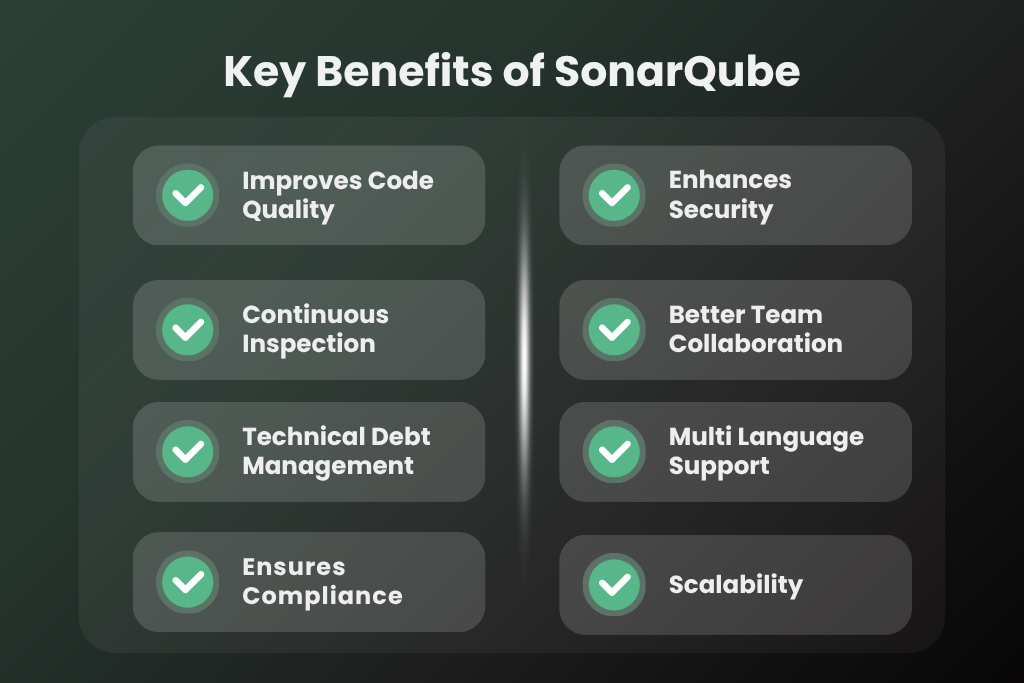SonarQube Explained: Features, Benefits, Setup & CI/CD Integration
14 +
Years of Experience
550 +
Happy Customers
250 +
Years of Tech Leadership Exp.

"License Reseller" and "Consulting & Implementation" Partner

Key Takeaways
- Comprehensive Code Analysis: SonarQube is a leading static code analysis tool that detects bugs, vulnerabilities, and code smells across 30+ programming languages.
- Seamless CI/CD Integration: Seamlessly integrates with CI/CD tools like Jenkins, GitHub Actions, GitLab CI/CD, Azure Pipelines, and Bitbucket for automated quality checks.
- Enhanced Security & Compliance: Enhances code security and compliance by providing real-time issue tracking, audit-ready reports, and built-in quality gates.
- Developer Productivity: Boosts developer efficiency through IDE integration with SonarLint, offering instant feedback and reducing rework.
- Continuous Improvement: Supports continuous code improvement with dashboards, coverage metrics, and historical trends that maintain long-term software health.
I still remember the first time I saw code issues pile up after release—technical debt, security holes, messy violations of DRY (Don’t Repeat Yourself). That’s when SonarQube became our go-to tool. In this blog, we’ll explore “What is SonarQube? And why use it?”—guided by real-world DevTools experience and packed with tips on CI/CD, audits, and code quality. Ready to level up?
What is SonarQube?

SonarQube is an open-source static code analysis platform from SonarSource that performs continuous inspection of code and helps developers keep their code clean and safe. It works by scanning your source code and automatically pointing out problems such as bugs, security risks, duplicated code, or hard-to-maintain logic. Think of it as a health check for your codebase.
It supports more than 30 programming languages and can be used in different ways:
- Self-hosted on a server for full control.
- Inside your IDE (with SonarLint) to catch issues as you code.
- In your CI/CD pipelines (GitHub Actions, GitLab CI/CD, Azure Pipelines, Jenkins, Bitbucket, etc.) to review every pull request before merging.
The best part? SonarQube integrates directly into your existing workflow so developers get instant feedback—without slowing down development.
Why is SonarQube important?
It is no longer optional to have clean, secure, and reliable code; it is a requirement. SonarQube is pertinent because it enables teams to have the transparency and techniques necessary to secure the quality of code, implement standards, and satisfy compliance laws without hampering development.
- Code quality and security: Auto-identifies defects, risks in code, code smells, duplication, and complexity.
- Built-in code quality: Your feedback is integrated into your IDE or CI pipeline, reducing fix cycles and getting quality gates past merge.
- Regulatory compliance & audits: Having the ability to show auditors or regulators what one is doing in real-time, as in the case of enum reports, you point to this as the current solution.
- DevOps synergy: Works perfectly with CI/CD pipelines in Azure pipelines, Jenkins, GitLab CI, GitHub actions, that automate the review of the code and provide an indication of the code health at any given step.
- IDE integration: With the help of SonarQube for IDE, developers receive alerts of smells and vulnerabilities as they code.
Pro insight: Gary Barter, Executive Director of DevTools, always reminds us that code quality is not optional when the audits, regulators, and clients require us to provide a real-time view of issues and are also security-conscious.
How do you install and set up SonarQube?

Prerequisites
- Java (11+)
- Database (PostgreSQL/MySQL/Oracle) or embedded H2 for trial
- 2 to 4 GB RAM (or 8+ for Enterprise)
- Docker installed (optional)
Installation Methods
1. ZIP File (Self‑Host)
- Download ZIP from SonarSource.
- Extract, edit sonar.properties to set DB credentials.
- Run via bin/linux-x86-64/sonar.sh start.
- Access the dashboard at http://localhost:9000.
2. Docker Image
- docker pull sonarqube: latest
- docker run -d –name sonarqube -p 9000:9000 sonarqube:latest
- Log in (admin/admin), generate a token under My Account → Security.
3. Other Installations
- Kubernetes, Helm, or cloud installs are supported.
- Once running, you’ll configure users, security tokens, and projects.
How do you integrate SonarQube with your project?
Integration with SonarQube is simple and powerful:
- Add SonarScanner or plugins for Maven, Gradle, and MSBuild.
- Integrate with your CI/CD pipeline:
- Jenkins: Use the SonarQube Scanner plugin. Add
withSonarQubeEnvandwaitForQualityGatesteps in your pipeline to enforce quality checks. - GitHub Actions, GitLab CI/CD, Azure Pipelines, Bitbucket Pipelines: SonarQube provides built-in integration for automated code reviews, code health tracking, and enforcing quality gates.
- Jenkins: Use the SonarQube Scanner plugin. Add
- IDE Integration: With SonarLint and SonarQube for IDEs, developers get inline suggestions and issue detection before code even reaches CI.
What are the core features of SonarQube?
SonarQube is packed with powerful features that help teams maintain high-quality, secure, and maintainable code across multiple languages and environments. These tools make it easy to spot issues early, enforce standards, and continuously improve codebases.
- Static code analysis – Spot bugs, security issues, and code smells. Helps developers detect issues early and maintain cleaner, more reliable software.
- Code coverage & test reports – Integrate tools like JaCoCo or Coverage.py. Identify untested code areas and improve unit test effectiveness.
- Code analysis – Check code duplication and complexity metrics. Simplify logic, avoid redundancy, and improve project maintainability.
- Quality gates – Fail builds based on code thresholds. Ensure only high-quality, secure code passes through CI/CD pipelines.
- Pull request decoration – Highlights issues in PRs before merging. Provides inline feedback within GitHub, GitLab, or Bitbucket.
- IDE integration – Real-time feedback in developer environments. Detect and fix issues instantly using SonarLint integration.
- Security features (SAST/SCA/IaC) – Detect secrets, vulnerabilities, and misconfigurations. Strengthen application and infrastructure security at every stage.
- Historical tracking – See code health trend lines. Monitor progress, prevent regressions, and maintain consistent quality over time.
- Custom rules & profiles – Tailor rules to your needs. Enforce coding standards and compliance specific to your organization.
- Multi-language support – Java, C#, JavaScript, Python, Go, and more. Ensure code quality across diverse technology stacks.
What are the key benefits of SonarQube?

When integrated into the development workflow, SonarQube adds significant value by improving both code quality and team efficiency. It not only detects issues early but also supports long-term maintainability and security.
Key benefits of SonarQube include:
- Improved Code Quality – Detects bugs, code smells, and vulnerabilities early, ensuring cleaner, more maintainable code.
- Enhanced Security – Identifies security flaws and provides guidance to fix them, reducing risks in applications.
- Continuous Inspection – Integrates seamlessly with CI/CD pipelines, enabling ongoing code analysis and faster feedback loops.
- Better Team Collaboration – Offers visibility into code issues across teams, promoting shared ownership of code quality.
- Technical Debt Management – Highlights areas of improvement, helping teams prioritize fixes and reduce long-term maintenance costs.
- Multi-Language Support – Supports 30+ programming languages, making it suitable for diverse development environments.
- Compliance and Standards Alignment – Ensures code meets industry standards and internal best practices, aiding in regulatory compliance.
- Scalability – Adapts to small teams or large enterprises, providing consistent insights across projects.
What are the benefits of high source code coverage with SonarQube?
High code coverage means more confidence in your code’s reliability. SonarQube makes it easy to track test coverage, identify gaps, and enforce testing standards to ensure production-ready software.
- Reduced risk of regressions – Ensures critical paths are tested.
- Earn audit confidence – Detailed reports help you respond to security and compliance questions.
- Quality gate enforcement – Blocks merges when test coverage dips below your threshold.
- Better code health dashboards – Spot untested modules and push coverage up.
How do you integrate SonarQube with Jenkins?
Here’s how DevTools did it for a recent client:
1. Install the SonarQube plugin in Jenkins:
Manage Jenkins → Plugins.
2. Configure the SonarQube server by setting global config and credentials (using secret tokens).
3. Add SonarScanner in Jenkins:
Manage Jenkins → Global Tool Configuration.
4. Update your pipeline script:
withSonarQubeEnv('MySonar') {
sh "${scannerHome}/bin/sonar-scanner"
}
waitForQualityGate abortPipeline: true
5. Run the job — Jenkins will now:
- Execute the SonarQube analysis.
- Call the quality gate.
- Fail automatically if violations are detected.
And just like that, we built automated code reviews, CI-integrated quality gates, and audit-ready metrics.
What are some advanced SonarQube components?
Beyond standard code analysis, SonarQube offers advanced features to enhance security, support architectural decisions, and automate workflows—empowering development teams at scale.
- Security add-ons (SAST/SCA/IaC scanning): Detect security issues, secrets, and IaC misconfigurations.
- Open source tracking: Scan third-party libraries via Software Composition Analysis.
- Code architecture insights: Structure101 integration for code architecture insights (via acquisitions).
- AutoCodeRover AI: Sonar’s latest, enhancing code analysis with LLMs.
- Process and workflow automation: Use APIs to link SonarQube issues with ticketing systems.
- Quality Gate orchestration: Central dashboards that tie results to DevOps pipelines.
How does SonarQube fit into a DevOps pipeline?

SonarQube is a vital component of modern DevOps pipelines, serving as the gatekeeper for quality and security. It integrates tightly with CI/CD workflows to catch issues early, reduce risk, and support continuous delivery.
- CI stage: Analyze code on each commit/pr via GitHub Actions, Jenkins, GitLab CI, or Azure Pipelines.
- Quality enforcement: Enforce quality gates to prevent merging poor-quality code.
- IDE feedback loop: Developers fix issues early using SonarQube for IDE integration.
- Release stage: Include summary reports for auditors or compliance teams.
- Monitor over time: Dashboards help align with long-term goals and regulatory standards.
We help clients integrate SonarQube in ci cd azure pipelines and CD Azure pipelines and Bitbucket workflows – ensuring code quality and security are baked in, not bolted on.
If you’re aiming for automated code reviews, integrated code quality, and audit-ready pipelines, DevTools can help. We assist with:
- SonarQube installation/setup (Docker or ZIP).
- CI/CD integration (Jenkins, GitHub Actions, GitLab CI, Azure Pipelines).
- Configuration of quality gates, code coverage, and security rules.
- Training teams to use SonarQube for IDE instant feedback.
- Implementing processes that address issues in real time and satisfy auditors/regulators.
Contact DevTools today and let’s ensure your codebase is secure, clean, and audit-ready.
Conclusion
SonarQube is more than a static analysis tool. It’s a DevOps-first platform for automated code reviews, quality gates, and integrated security scanning, working seamlessly with GitHub Actions, GitLab CI/CD, Azure Pipelines, Bitbucket, Jenkins, and IDE plug-ins. With strong coverage metrics and governance, you can confidently handle audits and regulatory checks in real time. At DevTools, we deploy SonarQube daily, and we’d love to help you do the same.
FAQs
What is SonarQube used for?
Static code analysis – detecting bugs, vulnerabilities, smells, and enforcing quality/security standards across languages.
What does SonarQube test for?
It tests for code smells, bugs, security vulnerabilities, duplications, complexity, test coverage gaps, secrets, and IaC misconfigurations.
Is SonarQube a code analysis tool?
Yes- a powerful static application security testing (SAST) engine that supports IDE use and CI pipeline integration.
Is SonarQube a DevOps tool?
Absolutely – it integrates across CI/CD environments like CI CD Azure pipelines, GitHub Actions, GitLab CI, and Jenkins for automated quality enforcement.
What is the difference between SonarQube and Jenkins?
- Jenkins is an automation/build server.
- SonarQube is a static analysis server focusing on code quality and security.
- They complement each other: Jenkins runs builds, SonarQube scans the resulting code. Together, they power automated code reviews and quality gates.
How Does SonarQube Improve Code Quality?
SonarQube improves code quality by detecting bugs early, highlighting complex or duplicate code, and identifying security vulnerabilities. It tracks test coverage, enforces custom coding standards, and promotes team-wide consistency to ensure cleaner, more maintainable, and secure code.




